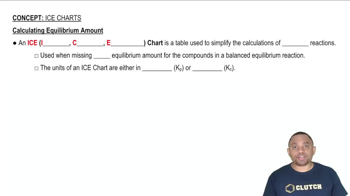Consider the reaction: HC2H3O2(aq) + H2O(l) ⇌ H3O+(aq) + C2H3O2-(aq) Kc = 1.8⨉10-5 at 25°C If a solution initially contains 0.210 M HC2H3O2, what is the equilibrium concentration of H3O+ at 25 °C?
Ch.16 - Chemical Equilibrium
Chapter 16, Problem 63
Consider the reaction: A(g) ⇌ B(g) + C(g) Find the equilibrium concentrations of A, B, and C for each value of Kc. Assume that the initial concentration of A in each case is 1.0 M and that the reaction mixture initially contains no products. Make any appropriate simplifying assumptions. b. Kc = 0.010
 Verified step by step guidance
Verified step by step guidance1
Step 1: Define the initial concentrations of the reactants and products. For A, the initial concentration is 1.0 M, and for B and C, the initial concentrations are 0 M.
Step 2: Set up the change in concentrations that occurs as the system reaches equilibrium. Let x be the amount of A that reacts to form B and C. At equilibrium, the concentration of A will be (1.0 - x) M, and the concentrations of B and C will each be x M.
Step 3: Write the expression for the equilibrium constant, Kc, in terms of the concentrations of the reactants and products at equilibrium. For the reaction A ⇌ B + C, the expression is Kc = \frac{[B][C]}{[A]} = \frac{x^2}{1.0 - x}.
Step 4: Substitute the given value of Kc into the equilibrium expression and solve for x. In this case, Kc = 0.010, so set up the equation 0.010 = \frac{x^2}{1.0 - x}.
Step 5: Solve the quadratic equation derived in step 4 for x to find the equilibrium concentrations of A, B, and C. The equilibrium concentration of A will be 1.0 - x, and the concentrations of B and C will each be x.

Verified video answer for a similar problem:
This video solution was recommended by our tutors as helpful for the problem above.
Video duration:
8mWas this helpful?
Key Concepts
Here are the essential concepts you must grasp in order to answer the question correctly.
Chemical Equilibrium
Chemical equilibrium occurs when the rates of the forward and reverse reactions are equal, resulting in constant concentrations of reactants and products. In this state, the system is dynamic, meaning that reactions continue to occur, but there is no net change in concentration. Understanding this concept is crucial for analyzing how concentrations shift in response to changes in conditions or equilibrium constants.
Recommended video:
Guided course

Chemical Equilibrium Concepts
Equilibrium Constant (Kc)
The equilibrium constant (Kc) is a numerical value that expresses the ratio of the concentrations of products to reactants at equilibrium, each raised to the power of their coefficients in the balanced equation. A small Kc value, such as 0.010, indicates that at equilibrium, the concentration of reactants is much greater than that of products, suggesting that the reaction favors the reactants. This concept is essential for predicting the direction of the reaction and the concentrations of species at equilibrium.
Recommended video:
Guided course

Equilibrium Constant Expressions
ICE Table (Initial, Change, Equilibrium)
An ICE table is a tool used to organize the initial concentrations, the changes in concentrations as the reaction proceeds, and the equilibrium concentrations of reactants and products. By setting up an ICE table, one can systematically determine how the concentrations of A, B, and C change in response to the reaction and the given Kc value. This method simplifies the calculation process and helps visualize the relationship between the species involved in the reaction.
Recommended video:
Guided course

ICE Charts and Equilibrium Amount
Related Practice
Textbook Question
2
views
Textbook Question
Consider the reaction: SO2Cl2(g) ⇌ SO2(g) + Cl2(g) Kc = 2.99⨉10-7 at 227 °C If a reaction mixture initially contains 0.175 M SO2Cl2, what is the equilibrium concentration of Cl2 at 227 °C?
1
views
Textbook Question
Consider this reaction at equilibrium: 2 BrNO(g) ⇌ 2 NO(g) + Br2(g) Predict whether the reaction will shift left, shift right, or remain unchanged after each disturbance. a. NO is added to the reaction mixture.
Textbook Question
Consider this reaction at equilibrium: 2 BrNO(g) ⇌ 2 NO(g) + Br2(g) Predict whether the reaction will shift left, shift right, or remain unchanged after each disturbance. b. BrNO is added to the reaction mixture.
